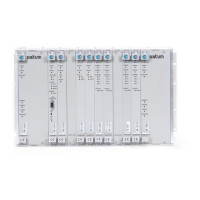Interactive Command Set
318 SSU-2000 User’s Guide 12713020-002-2 Revision D – April 2004
Command syntax follows these conventions:
{ } Signifies more than one parameters choice; one must be entered
Options are separated by vertical bars
| Pipe or vertical bar, used to separate multiple parameters or options
[ ] Signifies optional parameters
italics Signifies variable data
c Signifies character data (any printable ASCII character)
Terminology:
shelf The actual shelf number of the unit in the system: 1 indicates the
main shelf; 2 through 5 indicate expansion shelves.
slot The actual slot number in the shelf. Slot numbers begin at 1 and
number from left to right in the shelf.
port The actual port number in the slot. The port number begins at 1.
Comm port An EIA-232-C, Telnet, or Ethernet TL1 communications port.
Module selection follows these conventions. Each module selection in a unit is
defined as:
xAy, where:
x Shelf number (starting from 1);
A Place holder indicating the slot separator;
y Slot number (starting from 1, left to right, defined by each shelf).
Port selection follows these conventions. Each port of a module is addressed as:
xAy-z, where:
xAy same as defined for module selection.
z Indicates the port number, starting from 1, left to right
Legal module and port names follow the conventions illustrated by these examples:
1A5-3 indicates shelf 1, slot 5, port 3.
1A5 indicates a module in shelf 1, slot 5.
The ICS interface allows aliases for modules. Aliases follow the conventions shown
in these examples. For example, assuming a 19 inch chassis, these aliases apply:
CLK-A = Clock A, 1A1
CLK-B = Clock B, 1A12
2BUF-A = Shelf 2, Buffer A, 2A15
2BUF-B = Shelf 2, Buffer B, 2A16
3BUF-A = Shelf 3, Buffer A, 3A15

